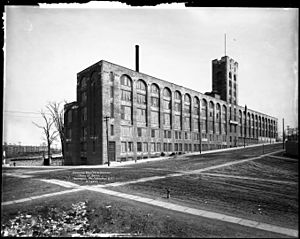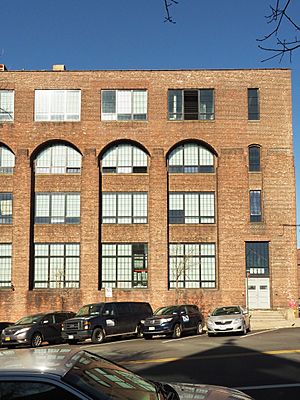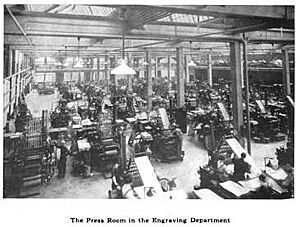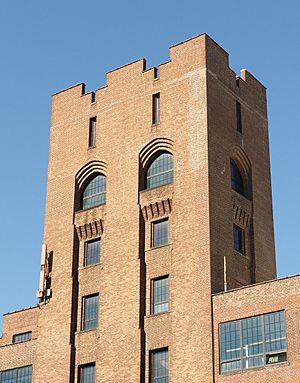American Bank Note Company Printing Plant facts for kids
Quick facts for kids American Bank Note Company Printing Plant |
|
|---|---|
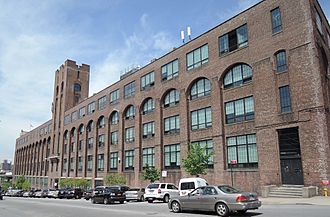
View from Lafayette Avenue
|
|
| Alternative names | American Banknote Company Building, The Penny Factory |
| General information | |
| Type | Printing Plant |
| Location | Hunts Point, the Bronx, New York City |
| Address | 1201 Lafayette Avenue, Bronx, NY 10474 United States |
| Coordinates | 40°49′01″N 73°53′26″W / 40.81694°N 73.89056°W |
| Construction started | 1909 |
| Completed | 1911 |
| Design and construction | |
| Architecture firm | Kirby, Petit & Green |
The American Bank Note Company Printing Plant is a large building in Hunts Point, the Bronx, New York City. It was built over 100 years ago, starting in 1909. The American Bank Note Company used it to print important documents.
This plant was special because it didn't just print paper money and stamps. It also made coins! Because of this, people in the area called it The Penny Factory.
The main building has three parts connected together. The Lafayette wing is the longest and tallest. It has the main entrance and a big tower. The Garrison wing is wider but not as tall, and it connects to the Lafayette wing. These two parts were built first. Later, the Barretto wing was added. There's also a smaller building called the North Building behind the main complex.
The buildings are huge, covering about 405,000 square feet. They take up an entire city block. The American Bank Note Company used this plant from 1911 until 1986.
They printed many things here, like:
- Paper money (bank notes)
- Stamps
- Stock and bond certificates (papers showing ownership in companies or loans)
- Checks
- Traveler's checks
- Letters of credit (financial guarantees)
- Lottery tickets
- Food stamps
- Other important financial papers
Even though the plant printed money for many countries, it was most famous for making money for countries in Latin America, like Mexico, Brazil, Costa Rica, Ecuador, Haiti, and Cuba.
Since 1986, the building has been sold a few times and fixed up. In 2008, it was named a New York City landmark. Today, it's divided into smaller spaces and rented out to different businesses.
Contents
History of the Land
What Was Here Before?
Before the printing plant was built, this land was part of a village called West Farms in Westchester County. The area where the plant stands was once a large estate owned by Edward G. Faile. He built a mansion called Woodside there in 1832. His family lived there even after he passed away in 1870. You can still see his legacy today with Faile Street nearby.
In 1874, this area became part of New York City. The Faile estate was sold in 1904 for about $1,000,000. By 1908, the land was owned by George F. Johnson.
Building the Plant
Why a New Location?
The American Banknote Company used to have many printing places in Manhattan. They wanted to put all their printing work in one big place. So, they looked for a new location for three years. In 1908, they bought the land from George Johnson.
The sale was a big deal, even reported on the front page of The New York Times. The old Faile mansion was taken down in 1909 to make room for the new plant.
Who Designed It?
The company hired Kirby, Petit & Green to design the plant. This same company also designed their main office building in Manhattan. The whole project was expected to cost about $2,000,000.
At the time, American Bank Note was a very big company, worth $10,000,000. They had printing plants in Boston and Philadelphia, not just New York City.
Jobs and Growth
The company expected to hire 2,500 to 3,000 people at first. The plant was even built big enough to hold up to 5,000 workers later on. Workers were paid well for their special skills. The new plant was also expected to help the neighborhood grow and increase property values.
Plant Design and Features
Early Ideas for the Building
When the plant was first planned, the New York Times described a design that was a bit different from what was actually built. This early idea had a long building along Lafayette Avenue for engraving and lithographing. Other parts would hold storage.
Later, a magazine called The Cement Age showed a design for "an ideal printing plant." The final building looked more like this "ideal" design. The Lafayette wing, with the only entrance, was a key part of both designs. This single entrance was important for security because of the valuable things being printed inside.
What the Plant Looked Like
When it was first finished in 1911, the plant had two main buildings: the long office building along Lafayette Avenue and a large press building next to it. Over the next few years, more parts were added. Like many printing plants, the buildings had open spaces, strong concrete floors, and high ceilings to fit the huge printing presses.
The plant had 200 presses, its own restaurant, a hospital, a laundry, and shops for machines and carpentry. They even had labs to create special inks! The plant needed a lot of electricity for all its machines and lights, so the New York Edison Company had to provide extra power.
In 2008, all the buildings on the Lafayette Avenue block were named a historic landmark.
Lafayette Wing Details
The Lafayette wing is a tall, narrow building that runs the entire length of Lafayette Avenue, almost 465 feet long. It held offices and rooms where printing plates were prepared.
The outside of the building is made of brick with a steel frame. This allowed for very large windows, which were unusual at the time. These big windows let in lots of natural light, which was important for checking the detailed and colorful printing work. The building also used modern electric lights.
The Lafayette wing was first built with three stories. In the middle of the building is a nine-story tower where the main entrance is located. In 1925, an extra story was added to the top of the building.
Garrison Wing Details
The Garrison wing is a three-story building that holds the printing presses. It has bigger open spaces, stronger floors, and taller ceilings to support the heavy machines. The lower floors had a vault to store over 130,000 printing plates. The top floor, where the presses were, had a special saw-tooth roof with many windows to let in natural light for inspecting the plates and printed documents.
North Building Details
A separate garage was built later at the corner of Garrison Avenue and Barretto Street. It was expanded in 1928 to make space for ink production.
Barretto Wing Details
In 1912, a one-story addition was built along Barretto Street, now known as the Barretto Street wing. It was used for a laundry and a pulp mill. This part was later made into three stories in 1928 and used for more presses and a machine shop.
Landscaping
The area next to the press building, along Tiffany Street and Garrison Avenue, used to have nice lawns, a curved driveway, and a walking path with lampposts. Today, the lawns have been replaced with a paved parking lot.
Other Buildings
The American Bank Note Company also built other buildings nearby. These included an employee welfare and research building, a distribution center, and a paper storage warehouse. These buildings are not part of the historic landmark.
Special Jobs at the Plant
In 1919, about 2,000 people worked at the plant. By the 1960s, the plant was handling over 5 million pieces of paper every day! It printed half of all the securities traded on the New York Stock Exchange.
The company hired the best engravers in the world. These artists would train for ten years or more. Some came from families who had been engravers for generations. In 1958, the main engraver was Will Ford, who had worked there for 46 years.
One very unusual job at the company was "counterfeiter." This person's job was to try and make fake copies of the company's own products. If they succeeded, the company would then improve its engraving, paper, or inks to make it even harder for real criminals to copy their documents. The "counterfeiting office" was in the tower, behind locked doors. Will Ford's father, William F. Ford, was one of these special "counterfeiters."
Building Damage
On March 20, 1977, the building was damaged by an explosive device placed near the Lafayette Avenue entrance. Windows were broken as high as the fourth floor. A group claimed responsibility, saying the plant was targeted because it was a "chief tool of capitalistic exploitation."
The next day, a false bomb threat was called in by a local resident. This person drove up to the plant, said they had a hand grenade, and dropped it. Luckily, it was just a harmless practice device.
After American Bank Note
By 1984, the plant had about 500 employees. The company moved its printing operations to a new location in Blauvelt, New York.
In 1985, the building was bought and turned into the Bronx Apparel Center. This center used about a third of the building and housed many clothing and fabric companies. The Bronx Academy of Arts and Dance also had space there. Other businesses included a wine cellar, a homeless shelter, a photography studio, and artist studios.
In 2007, the building was sold again for $32.5 million, and another $37 million was spent on renovations. It was sold again in 2014 for $114 million. Today, it's a very important part of the effort to improve Hunts Point.
Landmark Status
The New York City Landmarks Preservation Commission began looking into making the site a landmark in 1992. It was officially approved as a landmark in 2008. A special plaque in the main entrance points out its unique features, like the "crenellated tower" (a tower with battlements like a castle), "massive brick piers," and "saw-tooth skylights."
The head of the Landmarks Commission, Robert B. Tierney, said the plant was special because of its strong look in the neighborhood and its beautiful design. The building's design focused on security, with only one main entrance, even though it has over 1,500 feet of street frontage. The Real Deal magazine called it "one of the most architecturally distinctive office properties in the Bronx."
Important Businesses Inside
The John V. Lindsay Wildcat Academy Charter School has one of its campuses in the complex. The school uses three floors and has a Culinary Internship program, a student-run cafe, and a hydroponics garden.
The Bronx Academy of Arts and Dance first started in this building. They turned empty space into a theater for performances and workshops. They hosted the Arthur Aviles Typical Theatre dance company, which focused on Latino and LGBTQ cultures. This academy attracted other artists, who rented spaces from small studios to entire floors. However, they had to move out in 2012 because rents went up.
In 2010, the Sunshine Bronx Business Incubator opened in the building. It offered small spaces, even just one desk, to small businesses and startups. They could use shared meeting rooms and a reception area. This incubator helped new companies in technology, media, and healthcare. Sunshine closed down in 2017.
Getting There
The plant is right next to the New Haven & Hartford R. R. tracks, which are now part of the Northeast Corridor. When the plant was first built, the railroad added a special track just for the plant to receive goods. There are plans for a new Hunts Point station nearby, which would make it easier to get there by train.
The building is also close to Bruckner Boulevard, a major road. There is private parking next to the Garrison wing.
You can also get to the complex by subway. It's three blocks from the New York City Subway's Hunts Point Avenue or Longwood Avenue stations, which connect to Manhattan. The Bx6 bus line also runs along Hunts Point Avenue. For bikes, there's the South Bronx Greenway.
See Also
- links
- Video of event held in building, showing details of the Lafayette wing interior.
- Aerial video showing exterior of the building.
Images for kids



